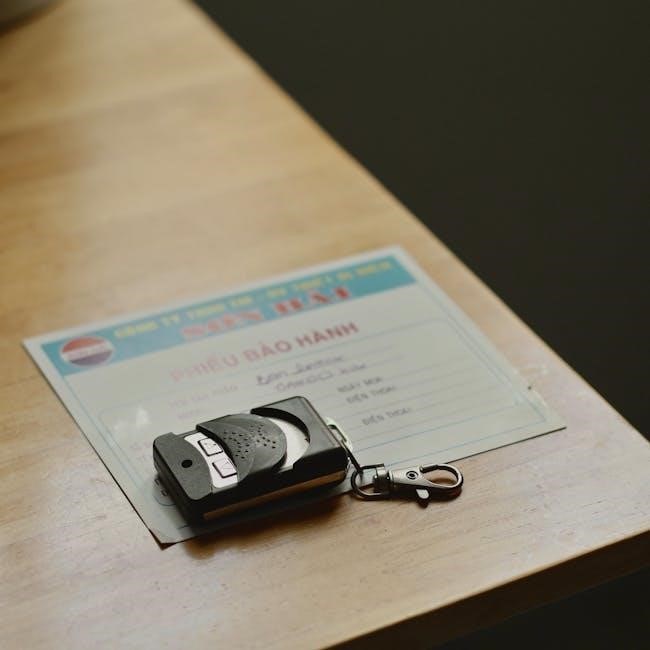lycoming overhaul manual
Summary
Don’t let your Lycoming engine sputter! Grab our Lycoming Overhaul Manual and get it purring like a kitten. Easy steps, expert tips, all in one place!

Lycoming Overhaul Manual: A Comprehensive Guide

This comprehensive guide navigates the intricacies of Lycoming engine overhaul manuals. These manuals contain vital information for major overhauls of horizontally installed direct drive engines. They offer step-by-step procedures, inspection criteria, and parts replacement guidelines, ensuring adherence to factory standards during restoration.
Lycoming overhaul manuals are essential resources for aircraft engine maintenance. These detailed documents provide comprehensive instructions for disassembling, inspecting, repairing, and reassembling Lycoming aircraft engines. They are crucial for ensuring the continued airworthiness and reliable performance of these engines. The manuals cover various engine models, including direct drive, geared, and supercharged configurations. Each manual is tailored to specific engine series, offering precise guidance for mechanics and technicians.
These manuals contain vital information, like overhaul procedures, component specifications, and torque values. Access to these manuals is critical for performing overhauls to FAA standards. Updates and revisions are periodically issued to reflect engineering changes and service experience. The manuals often reference Service Bulletins and Service Instructions for mandatory procedures and parts replacements. Understanding and adhering to these manuals is paramount for maintaining the safety and reliability of Lycoming-powered aircraft.
Availability of electronic versions, often in PDF format, has made these manuals more accessible to the aviation maintenance community, allowing for easy searching and referencing of critical information.

Applicability to Direct Drive Engines
Lycoming overhaul manuals hold specific significance when addressing direct drive engines. Direct drive engines, characterized by a crankshaft directly connected to the propeller, demand precise maintenance procedures detailed in the manuals. The manuals tailored for direct drive engines, such as the Avco Lycoming 60294 series, provide specific guidance. These manuals encompass all models within the direct drive family, unless otherwise specified, ensuring comprehensive coverage.
The manuals offer detailed instructions on inspecting critical components like the crankshaft, connecting rods, and pistons, unique to direct drive configurations. They emphasize proper torqueing procedures for fasteners and clearances for moving parts, vital for optimal performance and longevity. Ignition system maintenance, accessory housing overhaul, and cylinder/valve train procedures are also detailed with direct drive engines in mind.
Furthermore, the manuals highlight any model-specific differences within the direct drive engine range. Technicians rely on these manuals to ensure adherence to the correct procedures and specifications during the overhaul process, which contributes to the reliable and safe operation of direct-drive Lycoming engines.
General Overhaul Procedures
Lycoming overhaul manuals dedicate a substantial portion to outlining general overhaul procedures, offering a roadmap for technicians undertaking engine restoration. These procedures encompass a systematic approach, starting with a thorough engine disassembly and meticulous cleaning of all components. Detailed inspection follows, scrutinizing parts for wear, cracks, or any signs of damage that could compromise engine integrity. Measurements are taken to verify critical dimensions fall within acceptable tolerances.
The manuals then guide the reassembly process, emphasizing correct torque specifications for fasteners and proper installation of new or reconditioned parts. Specific attention is given to lubrication procedures, ensuring adequate oil flow to critical engine components. Clearances are carefully checked and adjusted to meet the manufacturer’s specifications.
Furthermore, the general overhaul procedures section often includes guidelines for leak testing, ensuring the engine is properly sealed after reassembly. Balancing rotating components, such as the crankshaft and propeller, might be addressed to minimize vibration and ensure smooth operation. The manuals stress the importance of documenting each step of the process, providing a record of the overhaul work performed, promoting traceability, and aiding future maintenance efforts.
Ignition System Overhaul
The ignition system is a critical component of any Lycoming engine, and its proper overhaul is meticulously detailed in the overhaul manual. This section provides comprehensive instructions for inspecting, testing, and overhauling the magnetos, spark plugs, and ignition wiring harness. Magneto overhaul involves disassembling the unit, cleaning all parts, and inspecting for wear or damage. Critical components like the coil, condenser, and breaker points are carefully examined, and replacements are specified when necessary.
The manual outlines procedures for testing magneto output and timing, ensuring optimal spark delivery to the cylinders. Spark plugs are thoroughly cleaned, inspected for electrode erosion and insulator damage, and properly gapped according to Lycoming specifications. The ignition wiring harness is inspected for cracked or brittle insulation, and terminals are checked for corrosion.
Specific procedures for testing the harness for continuity and shorts are provided. The overhaul manual emphasizes the importance of using specialized tools and equipment to perform ignition system overhaul correctly. Detailed diagrams and illustrations are included to aid technicians in understanding the components and procedures involved. Proper timing and synchronization of the ignition system after overhaul are crucial for engine performance and reliability, and the manual provides precise instructions for achieving this.
Accessory Housing Overhaul
The accessory housing of a Lycoming engine serves as a mounting platform and drive mechanism for various engine accessories, making its proper overhaul essential. This section of the Lycoming overhaul manual provides detailed instructions for the disassembly, inspection, repair, and reassembly of the accessory housing and its associated components.
The manual begins with step-by-step procedures for disassembling the accessory housing, carefully documenting the location and orientation of all parts. Each component, including gears, bushings, oil seals, and bearings, is meticulously inspected for wear, cracks, or other damage. Specific tolerances and wear limits are provided to determine whether a part can be reused or must be replaced.
The overhaul manual emphasizes the importance of thoroughly cleaning all parts to remove any contaminants that could affect performance or longevity. Instructions are provided for inspecting the accessory housing itself for cracks, distortion, or damaged threads. Bushings and bearings are inspected for proper fit and lubrication. Oil seals are replaced as a matter of course to prevent oil leaks. The manual includes detailed diagrams and illustrations to aid technicians in understanding the assembly and disassembly procedures.
Proper shimming and gear backlash adjustments are critical for ensuring smooth and reliable accessory operation, and the manual provides precise instructions for making these adjustments. Reassembly procedures are outlined in detail, ensuring that all parts are installed correctly and torqued to the proper specifications.
Cylinders, Pistons, and Valve Train Overhaul
The cylinder, piston, and valve train assembly is at the heart of the Lycoming engine, dictating its power output and efficiency. This overhaul section delivers detailed guidance on inspecting, reconditioning, and assembling these critical components, ensuring optimal engine performance and longevity.
Cylinder inspection involves meticulous checks for cracks, corrosion, and warping, especially around valve seats and spark plug bosses. The manual provides specific tolerances for cylinder bore diameter and out-of-roundness, guiding decisions on reboring or replacement. Valve guides are examined for wear, and valve seats are inspected for proper sealing and concentricity. The manual outlines procedures for valve seat grinding and replacement, ensuring a tight seal for optimal combustion.
Piston inspection involves checking for cracks, scuffing, and proper ring groove dimensions. Piston rings are meticulously inspected for wear, end gap, and side clearance. The overhaul manual specifies acceptable tolerances and wear limits for both pistons and rings, guiding replacement decisions. Connecting rods are inspected for straightness, twist, and bearing bore integrity.
The valve train, including valves, springs, retainers, and rocker arms, undergoes thorough inspection. Valve stems are checked for wear and proper clearance in the valve guides. Valve springs are tested for correct tension and free length. The manual provides detailed instructions for valve lapping, ensuring a proper seal between the valve face and seat. Detailed reassembly instructions, torque specifications, and critical adjustments are provided to ensure proper valve train operation.
Crankcase and Crankshaft Inspection and Overhaul
The crankcase and crankshaft form the backbone of the Lycoming engine, enduring immense stress and demanding meticulous attention during overhaul. This section of the manual provides detailed procedures for inspecting these components, identifying potential issues, and performing necessary repairs to ensure structural integrity and reliable engine operation.
Crankcase inspection involves a thorough visual examination for cracks, particularly around main bearing webs and mounting surfaces. Dye penetrant inspection methods are often recommended to detect subtle cracks invisible to the naked eye. The manual specifies tolerances for main bearing bore alignment and crankshaft journal bore dimensions. Instructions for repairing damaged crankcase threads and surfaces are also included.
Crankshaft inspection is equally critical, focusing on journal wear, cracks, and proper balance. Magnetic particle inspection is employed to detect surface and subsurface cracks. The manual provides detailed instructions for measuring crankshaft journal diameter, taper, and out-of-roundness. Grinding crankshaft journals to undersize dimensions is often necessary to restore proper surface finish and bearing clearance.

The overhaul manual also addresses the inspection and replacement of crankshaft bearings. Proper bearing clearance is essential for adequate lubrication and preventing premature wear. The manual provides detailed instructions for measuring bearing clearance using plastigage or other precision methods. Detailed procedures for crankshaft balancing, a critical step in minimizing engine vibration and extending component life, are outlined.
Reciprocating Parts Overhaul
This segment focuses on the meticulous inspection, repair, and replacement of vital reciprocating components within Lycoming engines. These parts, including connecting rods, pistons, piston rings, and wrist pins, endure considerable stress and heat during engine operation. Proper overhaul ensures their continued reliability and contributes significantly to overall engine performance and longevity.
The overhaul manual details procedures for visually inspecting connecting rods for cracks, bends, and distortions. Magnaflux inspection is recommended to detect any hidden flaws. Small end bushing wear and connecting rod alignment are meticulously checked, with instructions for reaming or replacing bushings as needed. Connecting rod bolts are carefully inspected for stretch and fatigue, and are often replaced as a matter of routine.
Piston inspection involves careful scrutiny for cracks, scuffing, and carbon buildup. Piston dimensions are measured to verify they are within acceptable limits. Piston rings are inspected for wear, breakage, and proper end gap. Cylinder bore condition is assessed to determine if honing or reboring is necessary to ensure proper ring sealing.
The manual provides guidelines for selecting the correct piston ring set and installing them with the proper orientation. Wrist pins are inspected for wear and proper fit within the piston and connecting rod. Clearances are carefully measured to ensure adequate lubrication and prevent excessive wear. Detailed instructions are provided for assembling the piston and connecting rod, ensuring proper orientation and secure fastening.
Engine-Specific Overhaul Manuals
Lycoming offers specialized overhaul manuals tailored to specific engine models, acknowledging the unique design characteristics and maintenance requirements of each. These engine-specific manuals delve into details not covered in general overhaul manuals, providing focused guidance for achieving optimal performance and reliability. Consulting the correct engine-specific manual is paramount during any Lycoming engine overhaul.
These manuals provide detailed information on the engine’s unique features, such as fuel injection systems, turbocharging configurations, and specific accessory drives. They include detailed parts lists with specific part numbers, torque specifications, and clearance values that are unique to that engine model. This level of detail is crucial for ensuring that all components are correctly installed and function as intended.
Engine-specific manuals often include troubleshooting guides that address common issues encountered with that particular engine model. These guides can help technicians diagnose and resolve problems quickly and efficiently. They may also include service bulletins and airworthiness directives that are specific to the engine, ensuring compliance with regulatory requirements.
Furthermore, these manuals provide detailed illustrations and diagrams that aid in the disassembly, inspection, and reassembly processes. These visual aids are invaluable for technicians, especially when dealing with complex engine components. They also include information on special tools and equipment that are required for overhauling the engine.
Time Between Overhaul (TBO) Considerations
The Time Between Overhaul (TBO) is a recommended interval established by Lycoming for engine overhaul, representing the period during which an engine should operate reliably under normal conditions. Adhering to TBO intervals contributes significantly to aviation safety and reduces the risk of unexpected engine failures. Factors such as operating environment, maintenance practices, and flight profiles can influence actual engine life.
While Lycoming provides TBO recommendations, it’s crucial to understand that these are guidelines, not absolute limits. Operators should consider their specific operating conditions and maintenance history when determining the optimal overhaul schedule. Engines operating in harsh environments, such as those with high levels of dust or humidity, may require more frequent overhauls. Similarly, engines subjected to high-stress operations, such as flight training or aerobatics, may benefit from shorter TBO intervals.
Regular engine monitoring, including oil analysis and cylinder compression checks, can provide valuable insights into engine health and help determine if an overhaul is necessary before reaching the recommended TBO. These proactive measures can identify potential problems early, allowing for timely repairs and preventing more serious damage. Ultimately, the decision to overhaul an engine should be based on a comprehensive assessment of its condition and operating history, rather than solely relying on the TBO recommendation.
Mandatory Parts Replacement During Overhaul
During a Lycoming engine overhaul, certain parts must be replaced regardless of their apparent condition. These mandatory replacements are critical for ensuring the engine’s continued reliability and safety. Lycoming specifies these parts based on their potential for fatigue, wear, or degradation over time, which could lead to catastrophic failure if not addressed.
Common mandatory replacement items include piston rings, connecting rod bolts, valve springs, and certain bearings. These parts are subjected to significant stress during engine operation, and their failure can have severe consequences. The overhaul manual clearly identifies all mandatory replacement parts for specific engine models, providing detailed instructions for their removal and installation.
Using only genuine Lycoming parts for these replacements is crucial. These parts are manufactured to strict quality standards and are designed to withstand the stresses of engine operation. Using aftermarket or non-approved parts can compromise engine performance and reliability, potentially leading to premature failure. Furthermore, meticulous documentation of all parts replaced during the overhaul is essential for maintaining accurate engine records and ensuring traceability in case of future issues. Adhering strictly to the mandatory parts replacement requirements outlined in the Lycoming overhaul manual is a fundamental aspect of a successful and safe engine overhaul.
Finding and Obtaining Manuals
Locating the correct Lycoming overhaul manual for your specific engine model is paramount for a successful and safe overhaul. Several resources are available to assist in finding and obtaining these essential documents. Lycoming Engines, the manufacturer, is the primary source for official overhaul manuals. Their website offers a comprehensive catalog of manuals available for purchase, both in print and digital formats.
Authorized Lycoming service centers and distributors also carry a selection of overhaul manuals. These centers often provide expert advice and can help you identify the correct manual for your engine. Online retailers specializing in aircraft parts and maintenance supplies are another avenue for sourcing manuals, but it’s crucial to verify the authenticity and revision status of the manual before purchasing.
When searching for a manual, be sure to specify the exact engine model and serial number. This ensures that you obtain the correct manual with the appropriate procedures and specifications. Pay close attention to the manual’s revision date, as Lycoming periodically updates manuals to reflect changes in engine design or overhaul procedures. Using an outdated manual can lead to incorrect procedures and potentially damage the engine. Always prioritize obtaining the latest revision from a reputable source to guarantee the accuracy and completeness of the information.
Updates and Revisions to Manuals
Lycoming overhaul manuals are not static documents; they undergo periodic updates and revisions to reflect engineering changes, service experience, and regulatory requirements. Staying current with these updates is crucial for ensuring the accuracy and effectiveness of overhaul procedures. Lycoming issues service bulletins and service instructions to communicate changes to overhaul procedures and specifications.
These documents often reference specific manual revisions and provide detailed instructions for incorporating the changes. It is the responsibility of the manual owner to maintain a current subscription to Lycoming’s service information distribution system or to regularly check for updates on the Lycoming Engines website. Updates can range from minor clarifications to significant changes in overhaul procedures or parts specifications.

Failing to incorporate these updates can lead to incorrect procedures, use of obsolete parts, and potentially compromise the safety and reliability of the engine. When receiving an update, carefully review the affected sections of the manual and incorporate the changes as directed. Make sure to record the date and revision number of each update in the manual’s record of revisions. Regular review and incorporation of updates ensure that the overhaul process is performed according to the latest approved procedures and specifications.